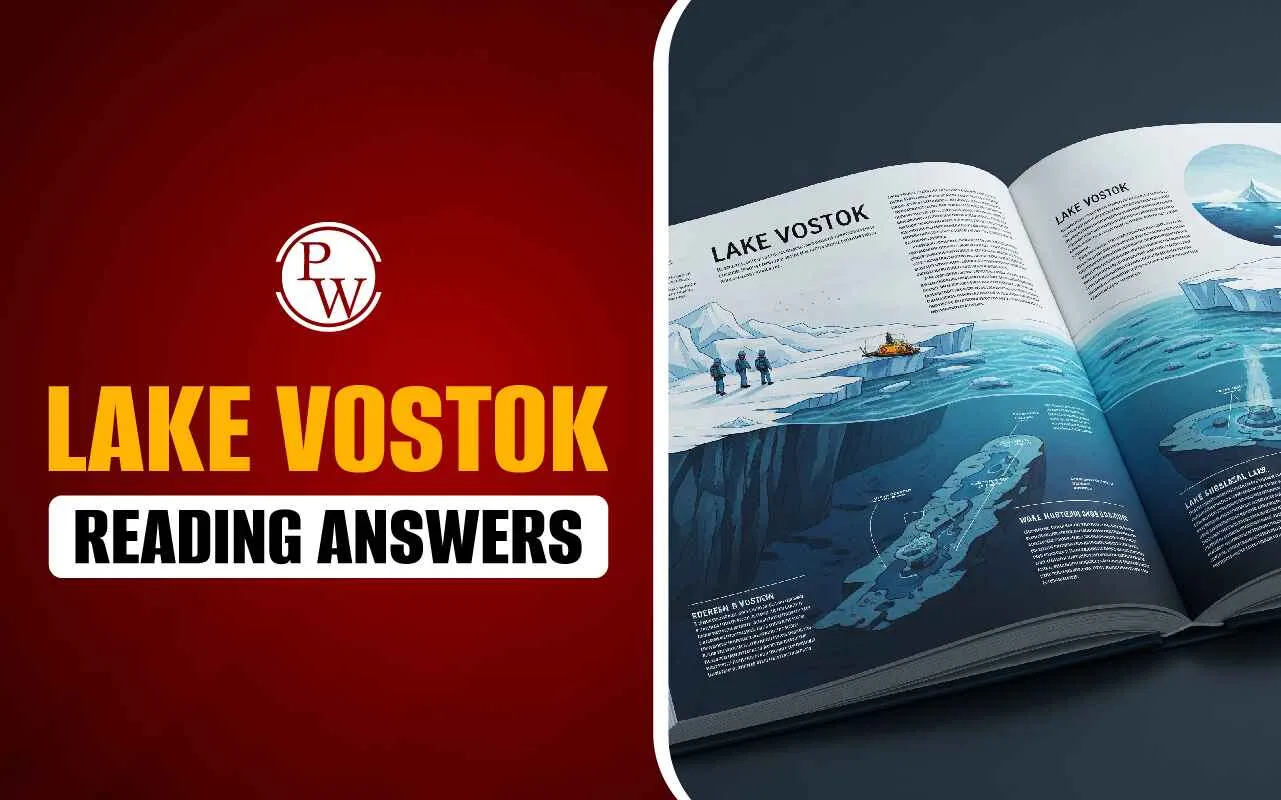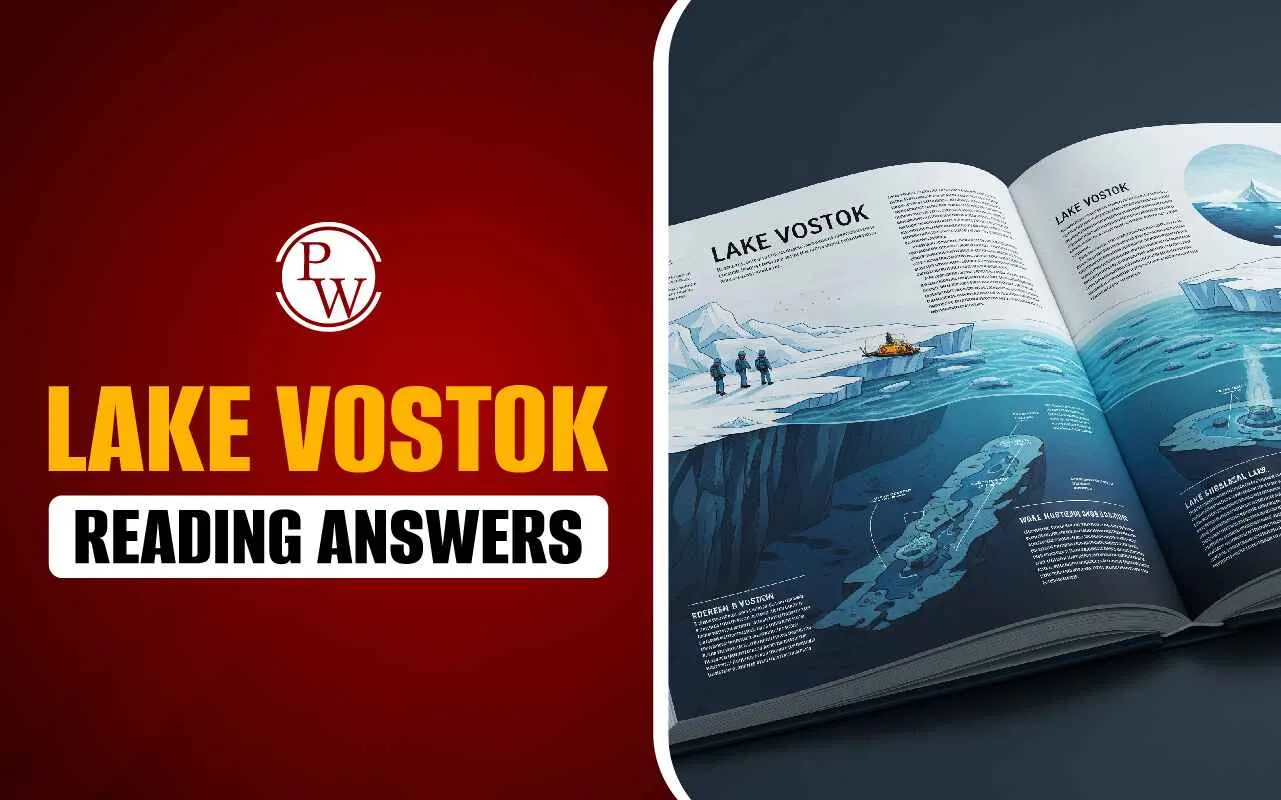

Lake Vostok Reading Answers: The IELTS reading passage on Lake Vostok explores a fascinating and lesser-known discovery beneath the frozen surface of Antarctica. Lake Vostok, hidden under nearly four kilometres of ice, is not just one of the world’s largest subglacial lakes, it is also a potential key to understanding Earth’s past climate and the possibility of life in extreme environments.
The passage presents a mix of scientific curiosity, technological challenges, and natural wonder, making it both informative and thought-provoking for test-takers. Here, we provide a detailed explanation of the Lake Vostok IELTS reading answers, along with question types, sample answers, and frequently asked questions.
Free IELTS Reading Practice Tests
Lake Vostok Reading Answers Passage
You should spend about 20 minutes on these IELTS reading questions based on the Lake Vostok passage.
Lake Vostok
-
Half of the continent of Antarctica is hidden beneath the ice and snow, and experts have no idea what treasures lay in wait there. An enormous lake, one of Earth's largest and deepest, was recently discovered by Russian and British glaciologists 4,000 meters below Russia's Vostok Station.
-
As more information about Lake Vostok has been public, the attention of scientists has increased dramatically. Sediment accumulated for millions of years at the lake's base may contain unique insights into the planet's climate over that time. Scientists hope to learn more about the history of Earth's temperature by analyzing the isotope ratio of oxygen. Lake Vostok's similarities to Europa have piqued NASA's interest. It appears that a massive ice layer, possibly tens of kilometers in depth, covers a water ocean on this Jupiter moon. if hydrothermal vents exist beneath the ice, chemical reactions on Europa may have produced the molecular building ingredients for life, if not life itself. Many experts have suggested that Vostok would be an excellent proving ground for spacecraft designed to travel to Europa and other faraway destinations. Any trip to Vostok would require a substantial investment, albeit it would be relatively inexpensive compared to a mission to Europa.
-
The record for the coldest temperature ever recorded on Earth was set at Vostok Station, which is a really unsettling fact. Readings from thermometers in July of 1983 show an average temperature of roughly -55 degrees Celsius. Paradoxically, it is the thick ice that allows a lake to persist in such a cold climate. The four kilometers of ice operate as an insulating covering, keeping the bedrock below warm even when exposed to subzero temperatures. The lake never freezes over because the deepest layers of ice are kept from freezing by geothermal heat from the Earth's interior. The immense mass of the ice sheet also contributes to the lake's stability. The pressure under a 4-kilometer-thick glacier is high enough to melt ice at a temperature of -4 degrees Celsius. Lakes have formed throughout much of the densely populated East Antarctica due to these circumstances. As of now, almost seventy underground lakes have been located in the isolated area of the continent. The largest is Lake Vostok, which is 280 kilometers long on its southern and northern edges and around 60 kilometers wide in its eastern and western parts. Seismic tests conducted by Russian scientists at Vostok station, located near the lake's southern end, indicate that its water depth likely exceeds 500 meters.
-
The presence of Lake Vostok was originally suspected in the 1970s, when scientists from the United Kingdom, the United States, and Denmark flew over the area to collect radar readings. The radar waves go through the ice and echo off of whatever is beneath. Researchers concluded that a lake was beneath the ice because the surface was as smooth as a mirror. The first step in actually drilling into the water of the lake is an aerial assessment of the entire lake. There are a lot of difficulties to face along with the possible benefits. Scientists need to find a means to break through the ice without contaminating the protected water with outside elements.
-
Is there really life down there? If the lake is inhabited by microscopic organisms, it may be among the most ravenous life forms ever found. It is possible that Lake Vostok is one of the most oligotrophic (energy-limited) places on Earth. The lake's inhabitants would have to rely only on subsurface sources of nutrition. Hydrothermal fluids containing reduced metals and other chemical nutrients have been theorized by Russian researchers to emerge from hot springs on the lake floor. Yet, the limited geological data available for this area suggests an ancient and defunct crust. Just what sits above the lake can provide energy, since there is no nutrient-rich water rising from the depths of the planet. As a result, the floating ice sheet is moving eastward at a rate of about four meters per year. When the ice touches the water of the lake, it begins to melt and releases trapped gases and shards of shattered rock. It's possible that the glacier is delivering organic substances that microbes can utilize if it recently brushed against a rock before reaching the lake. It may also be introducing new species into the lake, ensuring its continued population growth. Vostok ice core samples drilled to a depth of 2,750 meters (almost three-quarters of the way to the bottom) have yielded bacteria, yeasts, fungus, algae, and even pollen grains. Recent findings indicate that some of these organisms are alive and can grow. The analysis's findings could provide a clue as to whether or not anything is able to make it through the dark water.
Also Read:
Sample Questions: Lake Vostok IELTS Reading
Questions 1–5: Multiple Choice
-
What makes scientists interested in Lake Vostok?
-
Why might Lake Vostok resemble conditions on Europa?
-
What prevents Lake Vostok from freezing?
-
How was Lake Vostok first discovered?
-
What challenge must scientists overcome before drilling into the lake?
Questions 6–9: Matching Information
Match the following statements to the correct section of the passage.
A. Presence of possible microorganisms
B. Similarity to Jupiter’s moon
C. Discovery using radar
D. Subglacial lakes in Antarctica
Lake Vostok IELTS Reading Answers with Explanations
Answer to Questions 1-9
|
Question |
Answer |
Explanation |
|---|---|---|
|
1 |
Sediment may reveal climate data |
Scientists believe lakebed sediment holds valuable climate history. |
|
2 |
Thick ice covering water ocean |
The passage compares Lake Vostok’s conditions to Europa’s subsurface ocean. |
|
3 |
Geothermal heat + ice insulation |
These factors prevent the lake from freezing. |
|
4 |
Radar detected smooth surface |
Radar waves bouncing off smooth subsurface suggested a lake. |
|
5 |
Avoiding contamination |
Scientists worry about polluting the isolated ecosystem during drilling. |
|
6 |
A |
Microbial life forms may exist in the nutrient-poor lake. |
|
7 |
B |
Europa is considered similar due to its icy crust and possible ocean. |
|
8 |
C |
The lake was first detected using radar in the 1970s. |
|
9 |
D |
Conditions have allowed nearly 70 subglacial lakes to form. |
| IELTS Reading Band Score | IELTS Listening Band Score |
| IELTS Speaking Band Score | IELTS Writing Band Score |
Guidance of PW IELTS
Physics Wallah offers a few popular online IELTS courses for all students. Follow the latest IELTS articles to better prepare for the exam.
| IELTS Registration | IELTS Eligibility Criteria |
| IELTS Exam Pattern | IELTS Syllabus |
| IELTS Exam Dates | IDP IELTS Test Centers |











